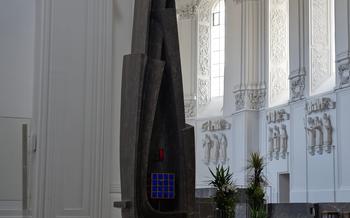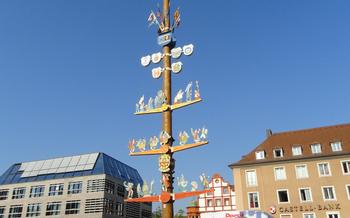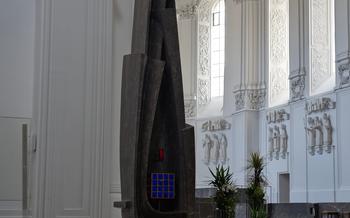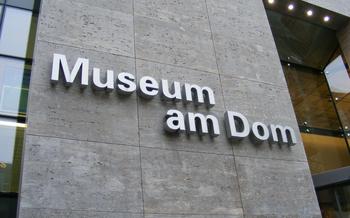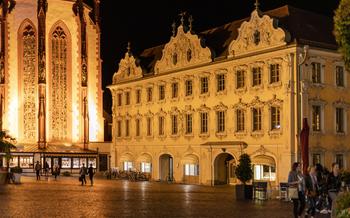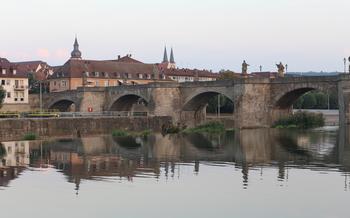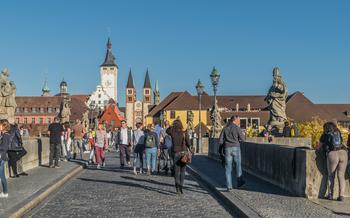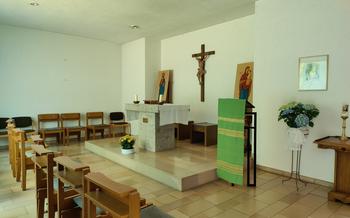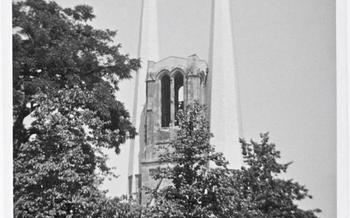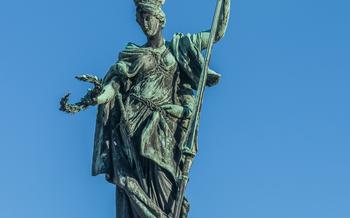
Domschatz Museum
- Würzburg's Domschatz Museum: A Hidden Gem
- A Treasury of Sacred Art
- Exploring the History of Würzburg
- The Würzburg Codex
- The Holy Spear
- The Works of Tilman Riemenschneider
- Interactive Exhibitions
- Guided Tours
- Souvenir Shop
- Admission and Hours
- Accessibility
- Photography Policy
- Nearby Attractions
- Food and Drink
- Insider Tip
Würzburg's Domschatz Museum: A Hidden Gem
Concealed within the heart of Würzburg, Germany, lies a treasure trove of sacred art and historical artifacts known as the Domschatz Museum. This remarkable institution, nestled beside the majestic Würzburg Cathedral, invites visitors to embark on a journey through time, exploring the rich cultural and religious heritage of the region.
A legacy spanning over a millennium unfolds within the museum's walls, showcasing a diverse collection meticulously preserved and curated. From intricate medieval manuscripts to resplendent goldsmith work and delicate ivories, each piece bears testament to the artistry and devotion of past generations. The Domschatz Museum stands as a testament to the enduring spirit of Würzburg, a city that has time and again risen from the ashes of adversity to reclaim its splendor.
Conveniently situated in the heart of the city, the Domschatz Museum is easily accessible by foot or public transportation. A short stroll from the Würzburg Hauptbahnhof (main train station) leads visitors to the museum's doorstep, where they can immerse themselves in the wonders that await within.
A Treasury of Sacred Art
The Domschatz Museum houses a remarkable collection of sacred art that spans centuries and showcases the artistic mastery of the region. Among the highlights are the medieval manuscripts, which are adorned with intricate illustrations and calligraphy. These manuscripts offer a glimpse into the religious and cultural life of medieval Würzburg.
The museum also boasts an impressive collection of goldsmith work, including chalices, monstrances, and reliquaries. These pieces demonstrate the skill and artistry of the goldsmiths who created them. The intricate designs and meticulous craftsmanship are a testament to the importance placed on religious objects in the past.
Another highlight of the collection is the ivory carvings, which depict religious scenes and figures. These delicate works of art showcase the talent and precision of the ivory carvers who created them. The carvings range from small pendants to larger pieces that adorn religious objects.
The collection at the Domschatz Museum is not only aesthetically pleasing but also historically significant. It provides a tangible connection to the past and offers insights into the religious and cultural heritage of Würzburg.
Exploring the History of Würzburg
The Domschatz Museum's collection is a testament to Würzburg's rich and storied history. It houses artifacts that span centuries, from the Middle Ages to the Renaissance and Baroque periods. These treasures provide visitors with a glimpse into the city's religious, cultural, and political heritage.
Among the medieval artifacts, visitors can admire exquisitely crafted manuscripts, goldsmith work, and ivories. These objects showcase the artistic and technical prowess of medieval craftsmen. The museum also houses a collection of liturgical vestments, including intricate embroideries and fabrics, which offer insights into the rituals and ceremonies of the Catholic Church during this period.
The Renaissance and Baroque periods were marked by a renewed interest in classical art and architecture. This is reflected in the museum's collection of paintings, sculptures, and decorative arts from this era. Visitors can marvel at the lifelike portraits, allegorical scenes, and elaborate ornamentation that characterized the art of these periods.
The Domschatz Museum's collection is not only a testament to Würzburg's history but also a valuable resource for scholars and researchers. The artifacts provide insights into the city's economic, social, and intellectual life throughout the centuries. The museum regularly hosts exhibitions and lectures that explore different aspects of Würzburg's history, making it a vibrant center for cultural and historical exchange.
The Würzburg Codex
The crown jewel of the Domschatz Museum is undoubtedly the Würzburg Codex, a masterpiece of early medieval book illumination created around 650 AD. This extraordinary manuscript, written in both Latin and Greek, contains the four Gospels and is renowned for its exquisite and intricate artwork.
The codex's 160 vellum pages are adorned with vibrant miniatures, historiated initials, and elaborate borders, showcasing the incredible skill and artistry of the unknown monks who created it. The illuminations depict biblical scenes, symbolic figures, and intricate geometric patterns, adding a layer of visual splendor to the sacred text.
The Würzburg Codex holds immense historical significance, as it is one of the oldest surviving illuminated manuscripts from the Merovingian period. It provides valuable insights into the artistic, religious, and intellectual climate of early medieval Europe and serves as a testament to the enduring power of faith and devotion.
Leafing through the pages of the Würzburg Codex is a truly awe-inspiring experience, allowing visitors to travel back in time and witness the vibrant artistic traditions of a bygone era. It is a masterpiece that continues to captivate and inspire scholars, art enthusiasts, and pilgrims alike, making the Domschatz Museum a must-visit destination for anyone interested in the cultural heritage of Germany.
The Holy Spear
The Domschatz Museum houses one of the most controversial and intriguing artifacts in Christendom: the Holy Spear. Legend has it that this spear pierced the side of Jesus Christ as he hung on the cross. Its history is shrouded in mystery and controversy, with claims that it was used by Roman soldiers, Charlemagne, and even Adolf Hitler.
The spear's origins are unclear, but it first appeared in recorded history in the 7th century when it was mentioned in the writings of Isidore of Seville. It was later passed down through the Holy Roman Emperors and eventually came into the possession of the prince-bishops of Würzburg.
The spear's authenticity has been debated for centuries. Some scholars believe it is the genuine article, while others dismiss it as a medieval forgery. In 1938, the Nazis seized the spear and displayed it in Nuremberg as a symbol of their supposed Aryan heritage. After the war, it was returned to Würzburg, where it remains on display today.
The Holy Spear is a powerful symbol, and its presence in the Domschatz Museum draws visitors from around the world. Whether you believe in its authenticity or not, there's no denying its historical and cultural significance.
The Works of Tilman Riemenschneider
Among the many treasures housed in the Domschatz Museum, the works of Tilman Riemenschneider stand out as some of the finest examples of late Gothic sculpture. Riemenschneider, a renowned sculptor active in Würzburg during the 15th and 16th centuries, was a master of his craft, and his works are admired for their intricate detail, emotional depth, and technical virtuosity.
One of the highlights of the museum's collection is Riemenschneider's "Twelve Apostles", a series of life-size sculptures originally created for the Marienkapelle in Würzburg Cathedral. Each apostle is depicted with his own unique personality and attributes, reflecting Riemenschneider's keen eye for observation and his ability to capture the essence of human character.
Another notable work by Riemenschneider in the museum is the "Madonna and Child", a tender and intimate portrayal of the Virgin Mary holding the infant Jesus. The sculpture is carved from a single block of limewood, and Riemenschneider's skill in handling the material is evident in the delicate folds of Mary's robes and the subtle expressions on her face.
Riemenschneider's works are not only aesthetically pleasing but also historically significant. They provide a glimpse into the religious and cultural life of Würzburg during the late Middle Ages and Renaissance, and they offer insights into the development of sculpture as an art form.
Interactive Exhibitions
The Domschatz Museum embraces the power of technology to enhance the visitor experience. Interactive displays and multimedia presentations bring the museum's collection to life, providing deeper insights into the history and significance of the artifacts. Visitors can engage with touchscreens to explore virtual galleries, zoom in on intricate details, and access additional information about the objects on display.
A highlight of the interactive experience is the "Virtual Reality Time Machine." This immersive virtual reality experience transports visitors back in time to witness significant moments in Würzburg's history. Through this technology, visitors can step into the shoes of historical figures, explore the city's streets as they were centuries ago, and gain a deeper understanding of the events that shaped Würzburg's rich heritage.
The museum also offers a range of multimedia presentations that delve into specific aspects of the collection. These presentations feature high-quality images, videos, and audio commentaries, shedding light on the techniques and artistic styles of the featured artists and artisans.
Whether you're a history buff, an art enthusiast, or simply someone who enjoys interactive experiences, the Domschatz Museum's use of technology will captivate and engage visitors of all ages.
Guided Tours
The Domschatz Museum offers guided tours in various languages, including English, German, and Spanish, allowing visitors to delve deeper into the museum's collection and its historical significance. These tours are led by knowledgeable and passionate guides who provide insights and anecdotes that bring the artifacts to life.
Taking a guided tour is an excellent way to maximize your visit to the Domschatz Museum. The guides can tailor the tour to your interests and provide personalized recommendations. They can also answer any questions you may have and help you understand the context and symbolism behind the artworks.
Guided tours typically last for about an hour and are available at specific times throughout the day. Visitors are advised to book their tours in advance, especially during peak season, to secure a spot and avoid disappointment.
Whether you're an art enthusiast, a history buff, or simply curious about the treasures of Würzburg, a guided tour of the Domschatz Museum is an enriching and memorable experience.
Souvenir Shop
The Domschatz Museum's souvenir shop offers a variety of items to commemorate your visit and share the treasures of Würzburg's history with your friends and family. From books and postcards to replicas of museum artifacts, you'll find a wide selection of souvenirs to suit all tastes and budgets.
The shop is located on the ground floor of the museum, just before the exit. It is open during the same hours as the museum and offers a convenient way to pick up a last-minute gift or a reminder of your visit to Würzburg.
Among the popular souvenirs available are books on the history of the museum and its collection, as well as postcards featuring images of the museum's most famous artifacts. You can also find replicas of medieval manuscripts, goldsmith work, and ivories, allowing you to take home a piece of history for your own collection.
The souvenir shop also offers a variety of unique and locally-made items, such as jewelry inspired by the museum's collection and traditional Franconian handicrafts. These make for thoughtful and authentic gifts that will remind you of your time in Würzburg and the Domschatz Museum.
Admission and Hours
Admission:
- Regular admission: €00
- Reduced admission (students, seniors, disabled visitors): €00
- Children under 18: Free admission
- Family ticket (2 adults and up to 3 children): €00
Hours:
- Tuesday-Sunday: 10:00 am – 5:00 pm
- Closed on Mondays
Discounts and Special Events:
- Free admission on the first Sunday of every month
- Guided tours are available for an additional fee
- Check the museum's website for information on special events and exhibitions
Tips:
- Purchase tickets online in advance to avoid queues.
- Take advantage of free admission on the first Sunday of every month.
- Guided tours are a great way to learn more about the museum's collection.
- The museum shop offers a variety of souvenirs, including books, postcards, and replicas of museum artifacts.
Accessibility
The Domschatz Museum is wheelchair accessible, with ramps and elevators providing easy navigation throughout the museum. Visitors with disabilities can also request assistance from the museum staff, who are always willing to help. Audio guides are available in several languages, providing a comprehensive description of the exhibits for visitors who are visually impaired or prefer to listen to the commentary. The museum also offers sign language tours for visitors who are deaf or hard of hearing. These tours are available upon request and should be booked in advance. The Domschatz Museum is committed to providing an inclusive and accessible environment for all visitors, ensuring that everyone can enjoy the museum's treasures.
Photography Policy
The Domschatz Museum allows visitors to capture the beauty of its collection through photography, but with certain restrictions in place to ensure the preservation of the artifacts and the enjoyment of all visitors.
Permitted Photography:
- Visitors are permitted to take photographs for personal, non-commercial use.
- Still photography without a flash or tripod is generally allowed in most areas of the museum.
- Taking pictures of individual artifacts for personal documentation or study purposes is generally permitted.
Restricted Areas:
- Photography is prohibited in certain areas, such as the treasury and the library, to protect sensitive or valuable items.
- Areas with restricted photography will be clearly marked with signs.
Flash and Tripod Usage:
- The use of flash photography is prohibited to prevent damage to the delicate artifacts.
- Tripods are not allowed in the museum's galleries as they can obstruct the walkways and disturb other visitors.
Respecting Others:
- Visitors are reminded to be respectful of other visitors and not block their view or disturb their experience while taking photographs.
- Using a selfie stick to take pictures is discouraged.
Commercial Photography:
- Professional photographers and commercial photography shoots require prior permission from the museum administration.
Copyright and Usage Rights:
- The Domschatz Museum retains the copyright to all images taken within its premises.
- Visitors are prohibited from using photographs for commercial purposes or public display without obtaining written permission from the museum.
Capturing the Best Shots:
- To capture the best shots, visitors are advised to adjust their camera settings to suit the low-light conditions in the museum.
- Using a wide-angle lens can be helpful for capturing the grandeur of the museum's interiors.
By adhering to the photography policy, visitors can help preserve the museum's collection while capturing their memories of this remarkable institution.
Nearby Attractions
Würzburg offers a wealth of attractions beyond the Domschatz Museum. Just a short walk away, the magnificent Residenz, a UNESCO World Heritage Site, awaits exploration. This former prince-bishops' palace boasts opulent rooms, stunning gardens, and a remarkable collection of art and artifacts.
For a picturesque stroll, cross the Alte Mainbrücke, the city's oldest bridge, and admire the panoramic views of the river and the charming cityscape. At the bridge's southern end, the Marienberg Fortress, perched atop a hill, invites you to delve into Würzburg's rich history. Explore its fortifications, its treasury, and its captivating views of the city and the surrounding countryside.
To immerse yourself in the city's vibrant art scene, visit the Museum am Dom, which showcases a diverse collection of modern and contemporary art. Alternatively, wander through the streets and discover the many galleries and studios showcasing the works of local and international artists.
Würzburg's compact city center makes it easy to explore these attractions on foot or by bike. Take advantage of the well-connected public transportation system, which offers convenient access to all parts of the city. Whether you prefer to stroll along the riverbanks, explore the historic alleys, or venture further afield, Würzburg promises a memorable and rewarding experience.
Food and Drink
Savor Local Cuisine Near the Domschatz Museum
After immersing yourself in the treasures of the Domschatz Museum, take a culinary journey through Würzburg's vibrant food scene. Within a stone's throw of the museum, you'll find a delectable array of restaurants, cafes, and bakeries to satisfy every palate.
For a taste of Franconian specialties, head to Backöfele, a charming bakery known for its mouthwatering pastries and hearty breads. Indulge in their signature "Schneeballen," a traditional sweet pastry dusted with powdered sugar.
If you prefer a sit-down meal, Die Weinstube offers a cozy atmosphere and an extensive menu featuring regional dishes. Their "Schäufele," a slow-roasted pork shoulder, is a must-try for meat lovers.
For a quick bite, Café Central is a popular spot for locals and tourists alike. Enjoy a cup of freshly brewed coffee and a slice of their homemade cake while soaking in the lively ambiance.
Vegetarian and vegan visitors will find plenty of options at Bioladen Lebensbaum, a health food store with a deli counter serving delicious plant-based dishes.
Remember to sample the local wines, a source of pride for the Franconian region. Weingut Juliusspital and Weingut Bürgerspital are two renowned wineries offering tastings and tours.
Insider Tip: For a unique dining experience, consider booking a table at Zur Schwane, a historic restaurant housed in a former monastery. Their traditional German cuisine and stunning riverside views are sure to create a memorable evening.
Insider Tip
Venture beyond the main exhibition halls to discover hidden treasures in the Domschatz Museum. In a secluded corner, you'll find a small room dedicated to the history of bookbinding. Here, intricate medieval manuscripts are displayed alongside antique printing presses, offering a glimpse into the art of bookmaking from centuries past. Don't miss the opportunity to admire the stunning craftsmanship of these rare and valuable volumes.
To avoid the crowds and fully immerse yourself in the museum's offerings, plan your visit for a weekday morning. This will give you ample time toじっくりと explore the exhibits without feeling rushed. You'll also have the chance to engage in meaningful conversations with the knowledgeable museum staff, who are always happy to share their insights and answer your questions.
